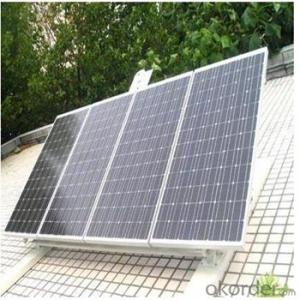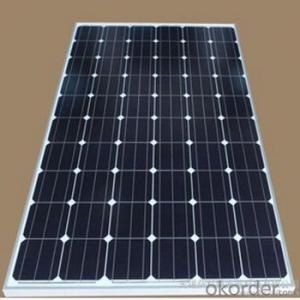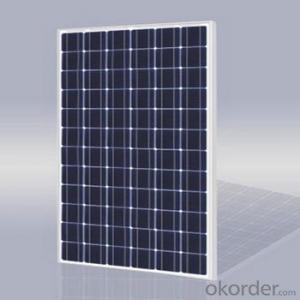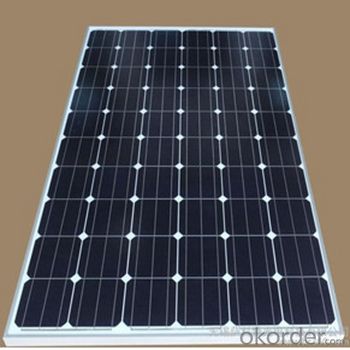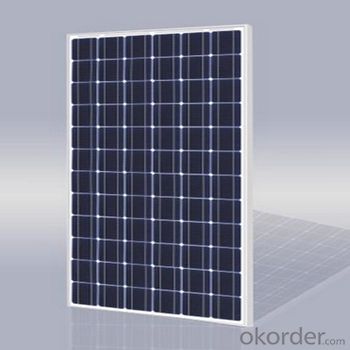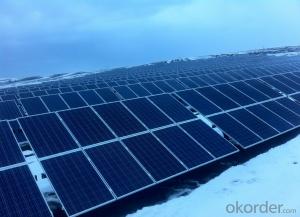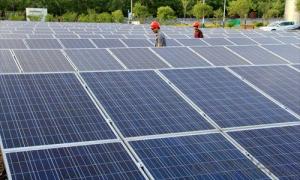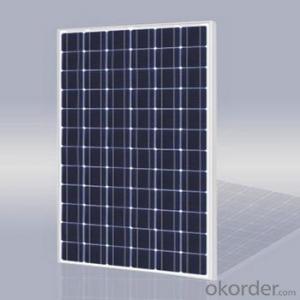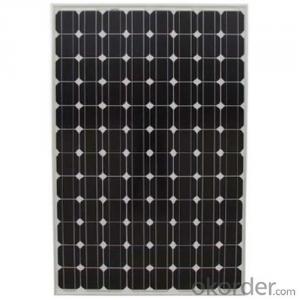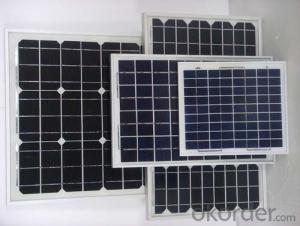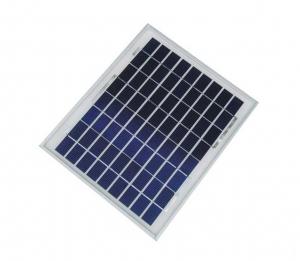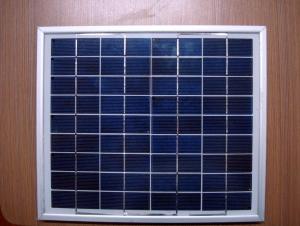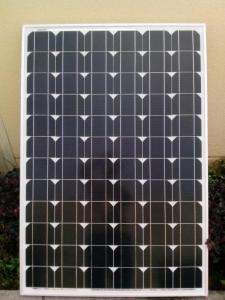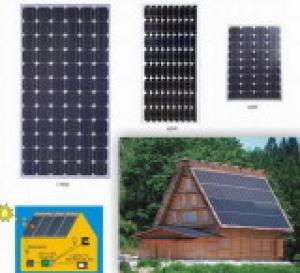Pasadena Solar Panels - Solar Monocrystalline Panel Series (45w-50w)
- Loading Port:
- Shanghai
- Payment Terms:
- TT OR LC
- Min Order Qty:
- 100 pc
- Supply Capability:
- 30000 pc/month
OKorder Service Pledge
OKorder Financial Service
You Might Also Like
Description:
Solar Monocrystalline Series (45W—50W) l : High efficiency crystalline solar cell. Even if under the weak light, the solar module can produce maximum power output.
II Tempered glass (toughened glass): Anti-reflecting coating and high transmission rate glass increase the power output and mechanical strength of solar module.
III EVA and TPT: Using high quality EVA and TPT to prevent destroying and water.
IV AI frame: Without screw, rner connection. 6 holes on the frame can be installed easily.
V Junction box: Multi function junction box with water proof.
VI Long lifetime: ≥25 years; Less power decrease.
VII Good performance of preventing from atrocious weather such as wind and hails.
VIII Resisting moisture and etching effectively, not effected by geology.
Standard Test Conditions of Solar Monocrystalline Series :
The opto-electrical specifications shown below are stabilized values being measured at Standard Test Conditions, Irradiance: 1000W/m2, Spectrum: AM1.5 at 25°C, The info below is subject to manufacturing tolerances. Where appropriate minutes of measurement are available and are used for the dimensioning of the installation.
Advantages of Monocrystalline Silicon Solar Panel
• CNBM Solar performance guarantees for 25 years
• 12 years guarantee for workmanship
• Timeliness of delivery
Specification of Solar Monocrystalline Series
- Optimal permutation on solar cells to keep enough heat diffusion, decreases hot spot effect.
- High quality and anti-ageing EVA, weather resistance backside raw materials assure reliable solar panels.
- Passed 5400Pa mechanical loads testing by UL, can withstand bad and high mechanical load working environment.
- With good sealed performance, moisture resistant, aging resistance, high/low temperature resistant, the inner terminals of our junction box owns good electrical performance transmission. Bypass diodes used can avoide hot spot effect and damages to panels. Output cables and mating connectors are safe and reliable for installation application. Adopt weather resistance, sealed, good sticky silica gel when assembling.
- Strict quality inspection on each procedure and 100% electrical performance test to meet power requirements.
- 0~+3% power tolerance.
- classification for all the panels in order to improve the integral performance of system and solar panel life span.
- TUV、UL、MCS、CE、ROHS、Golden Sun certified
- Underwriting of 25years output power warranty by The People's Insurance Company of China.

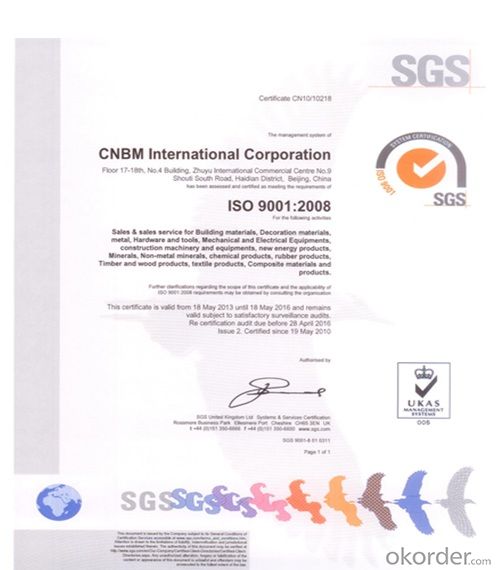
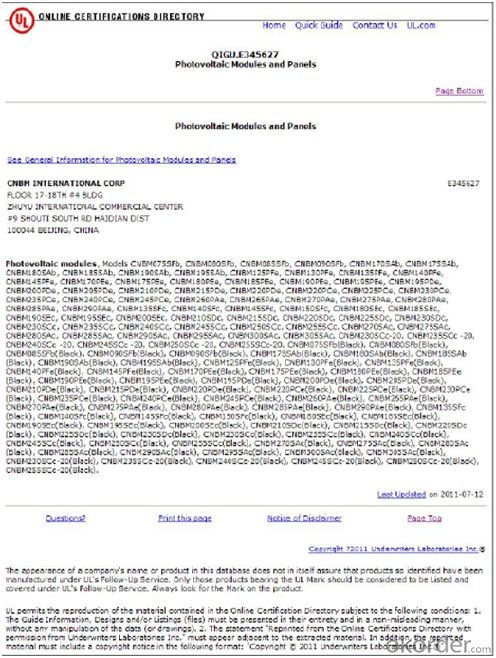
FAQ
We have organized several common questions for our clients,may help you sincerely:
①What price for each watt?
It depends on the quantity, delivery date and payment terms,
②What is your size for each module? Can you tell me the Parameter of your module?
We have different series of panels in different output, both c-Si and a-Si. Please take the specification sheet for your reference.
③Can you provide the peripheral products of the solar panels, such as the battery, controller, and inverter? If so, can you tell me how do they match each other?
Yes, we can, we have two companies for solar region, one is CNBM International, the other is CNBM engineering Co.
We can provide you not only the solar module but also the off grid solar system, we can also provide you service with on grid plant.
④What is your warranty system?
Our product performance guarantees for 25 years
• 12 years guarantee for workmanship
• Timeliness of delivery
• Quality Products certified (TÜV, UL, CE, ISO)
⑤How do you pack your products?
We have rich experience on how to pack the panels to make sure the safety on shipment when it arrives at the destination.
⑥ Can you do OEM for us?
Yes, we can.
⑦How long can we receive the product after purchase?
In the purchase of product within three working days, We will arrange the factory delivery as soon as possible. The pecific time of receiving is related to the state and position of customers.Commonly 7 to 10 working days can be served.
- Q: Is it possible to store energy from solar panels for night?
- Solar Power At Night
- Q: Hi, I am starting to get curious about the pros/cons of installing solar panels - has anyone done it and is it worth it?
- In the state of Pennsylvania in the USA, a very basic 5KW solar installation will cost you $35,000. Of that you will recover approximately $28,000 over the next five (5) years between the State and the Feds. Making your net-cost something between $7,000 and $9,000 depending on various factors. All other things being equal in a standard household with fuel-based heat and window units vs. central AC, this system will provide roughly 50% of power required with a payback of approximately eight (8) years (with electricity at $0.4/kwh). The system has an estimated forty (40) year service life. Without _all_ the subsidies, the payback is longer than the estimated system life, especially if you consider the time-value of money. The life-cycle cost of a photo-voltaic array is horrendous. By that, I mean the total cost of producing the panels, installing them, and then removing them and disposing of them in an environmentally correct manner. All that added in and there is a negative payback. So, it all depends on what one defines as worth it. Putting the cost onto taxpayers via governmental subsidy to make an otherwise wretchedly expensive process viable may give you all sorts of warm-and-fuzzy feelings about renewable resources and reducing dependence on foreign oil and so forth. But the reality is that the true cost of solar panels exceeds that of nuclear power per KW delivered. Even today when nuclear plants start in the Billions-with-a-B in any currency you would care to name.
- Q: Can solar panels be used to power a telecommunications network?
- Yes, solar panels can be used to power a telecommunications network. Solar power is a sustainable and renewable energy source that can be harnessed to generate electricity for various applications, including powering telecommunication infrastructure. By installing solar panels, the telecommunications network can operate with minimal reliance on the grid, reducing energy costs and environmental impact. Additionally, solar power can be stored in batteries to ensure uninterrupted power supply even during periods of low sunlight.
- Q: Can solar panels be installed on wearable devices?
- Yes, solar panels can be installed on wearable devices, but their effectiveness may be limited due to the small surface area available for solar absorption. Additionally, the amount of energy generated may not be sufficient to power the wearable device continuously. However, advancements in solar technology may make it more feasible and efficient in the future.
- Q: Can solar panels be installed on carports or pergolas?
- Yes, solar panels can be installed on carports or pergolas. These structures provide ample space for installing solar panels, allowing them to generate clean and renewable energy while also providing shade and protection for vehicles or outdoor spaces.
- Q: We see increasing, what appear to be, solar panels on electric poles?
- Usually they are used to power monitoring units that transmit data to a central point on usage and/or line loads. They may also be used to supply power to some control circuits, and to allow remote control of these units. (If there was no power in the line, how else could you supply the needed power to obtain information and/or control these things remotely.) What they do is keep a standby or backup battery charged to operate the equipment. They are also used for self-powered lights in many areas, charging batteries during the day to run the light(s) at night. Similar systems are used on monitoring wells to transmit water table data. (Faster, cheaper, and more timely than sending someone around to make checks and read equipment once every couple of months.)
- Q: i'm making a small solar panel powered fan but it cant run the cellphone vibration motor even i have place two x2 solar panel.
- this type of solar panel has some few watts. Ah is a quantity (which represent energy) that define the flow of ampere for a period of hour. so, the max instant electric current is 40mA and the max power is 40mA x 3.6 = 0.44 watts but, this value depends of the solar ilumination which the panel is subjected.
- Q: Due to erratic power cuts in my area I want to make up by using a 30watt solar panel. My decoder is 30watt but my TV is 70W. I need something small. I don't have problem with sound. Just picture.
- Do what we do when power is cut (although we have very reliable power - we loose as much as 2 hours a year), is go Amish. That is go without powered technology. Now, for you, you need more than a solar panel (and likely more than 30W, but that is a start) - you need a battery or set of batteries to store the collected power. 20Ah might do. You need an inverter to power things. For that, likely a 300W will do. For a TV, go shopping, and look at the labels on the back of the TVs. I just bought a 24 TV rated at 40W. If you get a 9 LED TV, it may be likely you can run that directly from battery, for many have separate DC brick supplies. With those, you can make a cable to power it directly from a 2V or so battery, if the supply can make 2 to 5V. Depending on your provider, you may be able to get a mini-decoder which uses a separate brick or wall supply, which means the decoder likely can be directly battery powered. Such a decoder may draw less than 20W.
- Q: Can solar panels be damaged by hail?
- Yes, solar panels can be damaged by hail. Hailstones can cause physical damage to the panels, such as cracks or shattered glass, impairing their ability to generate electricity efficiently.
- Q: Well, I am looking for a cheap way on building a solar panel, instead of buying by the manufacturing stores. I would like to stay in the budget up to ,000 dollars. I want to have Solar Energy for my house because the sun is always shining. Is there a way I can make the Light power some of my house? What would I need? How much time would it take?Where can I get the items I need?
- The panels themselves- no. Minimal. For most it is just hosing them off with water as needed to remove dust. Battereis on the other hand are usually needing attention every week to maintain the electrolyte levels. The exception being AGM types. Periodic desulphating may be needed on older setups, but beyond that keeping chickens are more demanding. Batteries are how you store your energy for periods when demand exceeds what the panels can deliver, and at night. How many varies. Factors of how you use energy has most impact. Some people can get by with a few hundred Watts, for others 3 to 5 Kilowatts are needed. For the average American, 5 to 7 Kilowatts as a minimum without some serious changes to how energy is used.
Send your message to us
Pasadena Solar Panels - Solar Monocrystalline Panel Series (45w-50w)
- Loading Port:
- Shanghai
- Payment Terms:
- TT OR LC
- Min Order Qty:
- 100 pc
- Supply Capability:
- 30000 pc/month
OKorder Service Pledge
OKorder Financial Service
Similar products
Hot products
Hot Searches
Related keywords
